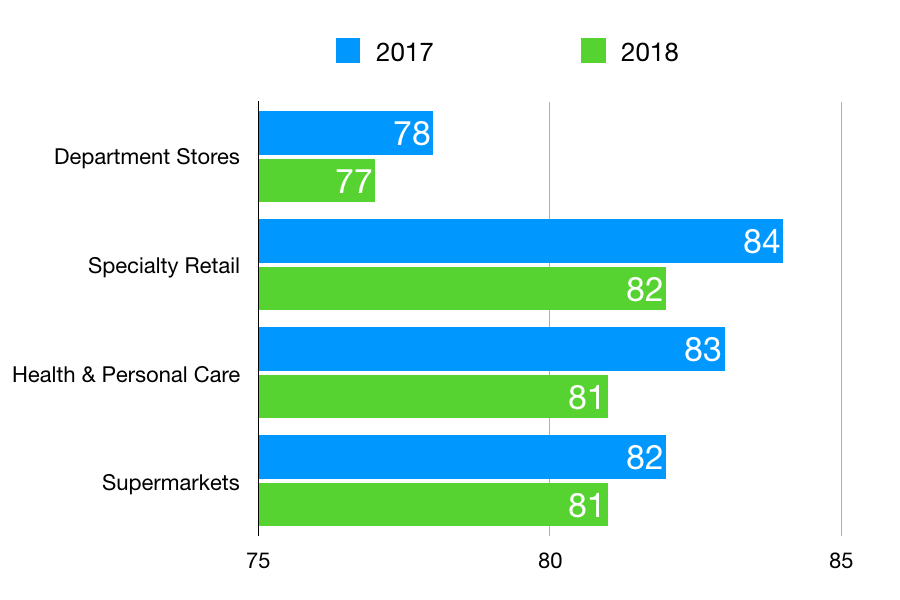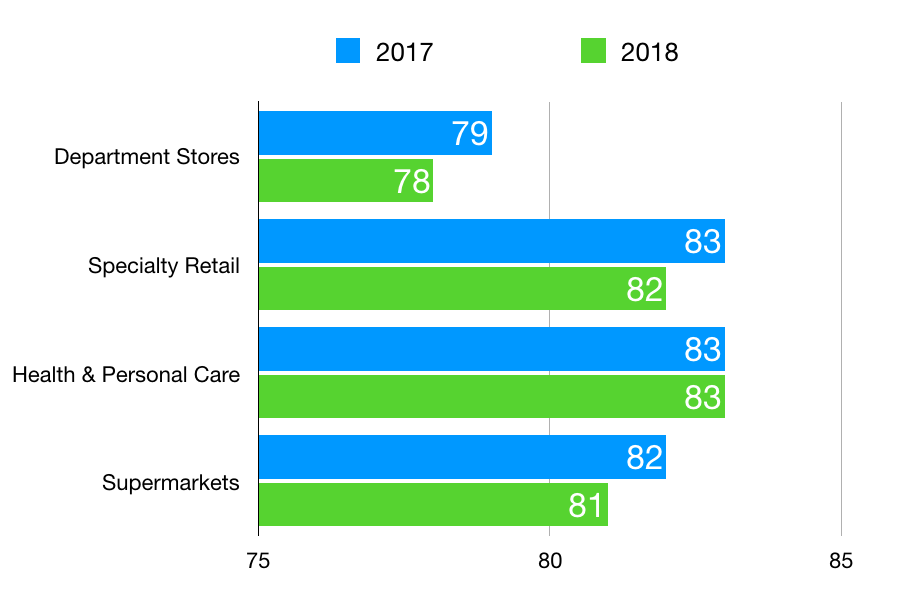A new report from the American Customer Satisfaction Index shows a drop in retail customer satisfaction. From department stores like Nordstrom to specialty stores like Bed Bath & Beyond, customers are less happy than they were a year ago.
How can this be possible in an era where customers are bombarded with survey requests and access to big data is at an all-time high?
The answers have to do with people. How people are staffed, managed, and the duties they are asked to perform all have an impact on customer satisfaction.
You can access the full report or read below to see the highlights and analysis. To kick things off, the chart below shows a comparison in overall satisfaction between 2017 and 2018 on a 100-point scale:
Retail customer satisfaction declined from 2017 to 2018.
Trend #1: Courtesy and Helpfulness of Staff
This one is down across the board.
Courtesy and helpfulness from retail employees has declined.
Staffing levels have a big impact on this category. Retailers routinely understaff stores in an effort to save money, but this leaves the few available employees running ragged trying to serve multiple customers and complete tasks like restocking and merchandising.
Another issue is the surveys that seemingly appear on every retail receipt. These should help retailers detect problems like unfriendly employees. But the dirty secret is many retailers don't actually use those surveys to improve. And many even manipulate the surveys to make the scores look better than they really are.
A 2016 report from Interaction Metrics found that 68 percent of retail customer satisfaction surveys were "total garbage."
Trend #2: Layout and Cleanliness of Store
There's a slight dip in this area.
Stores need to improve the cleanliness and layout.
Part of the challenge is staffing (see Trend #1). Stores struggle to stay clean and organized when there aren't enough employees to do the work.
Another is command structure. Many retail chains make store layout decisions at the corporate level, and don't do enough field testing to ensure the designs actually make sense. Last year, I did a comparison of my local Walgreens, Rite Aid, and CVS and noted important differences in the layout of each store.
Trend #3: Speed of Checkout Process
The checkout process was another area where satisfaction dropped across the board.
Checking out is too slow at retail stores.
Here again staffing plays a role. We've probably all wasted time wandering around a department store, searching for someone to ring us up. And that's precisely why so many people would rather shop online—it's much easier.
Customer satisfaction with speed isn't just about the actual amount of time it takes. People are heavily influenced by perception. So a pleasant experience with a friendly cashier that takes five minutes will feel like a breeze, while an unpleasant experience that also takes five minutes will feel like an eternity.
Retailers could help themselves by studying these factors that influence wait time perception.
Take Action
There are three easy ways retailers can check these trends in their own stores.
Talk to employees. I have no idea why managers don't spend more time doing this. Employees will almost always be forthcoming about the challenges they face if you ask them sincerely.
Walk your stores. Spend time walking through your stores like a customer. You'll often discover unexpected problems that your customers encounter every day.
Use surveys wisely. Customer feedback surveys can be valuable tools, but you should use them wisely or not use them at all. This short video will help you decide why you want to run a survey program.





